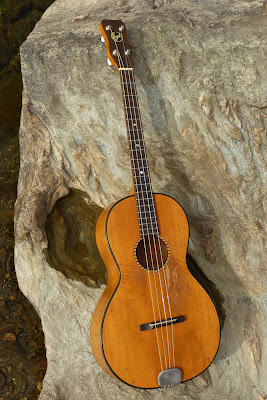c.1930 Regal Tenor Guitar
Ah yes, the classic size-5 12-fret Regal tenor! It should be a staple in any tenor player's collection!
Prices on these guys just keep jumping up and up and up and for good reason: once they've been gone-through they make excellent little guits. This one is no slouch and has an amazingly full, loud, warm sound. I wouldn't be surprised if it made an excellent tenor for Celtic (GDAE) tuning, though I've got it in CGDA (standard) at the moment. I'm always surprised at how big these things sound. It's probably due to the mix of light build, good woods, and 12-fret body putting that bridge right in the sweet spot.
Work on this guy included a fretboard extension reglue, some hairline crack cleating and repair, a seam repair and crack fill/cleat to the back, a fret level/dress, replacement tuners, bridge modification, cleaning, and setup. It had a neck reset (non-pro but decent work) done in the past, so the neck was already stable. While regluing the fretboard extension (it was sloped "up" so needed to be reglued down) I also popped a shim in the neck dovetail to keep that neck stable for the long haul (Chicago guitars tend to have voids in the dovetail joint which is why the joints often fail vs. more secure Gibson/Martin joints).
These are handsome little guys with a smallish size-5 body (10 1/2" x 15") and short 21" scale. Add to that a 12-fret joint and you have something that sits really nicely in the lap -- just about the size of an oversize baritone ukulele. The nut width is 1 1/4" which makes complicated chords a little easier vs. the usual tenor-style 1 1/8" nut width which can sometimes feel cramped.
Tenor guits are getting popular among uke and mandolin players for their adaptability to "native" tunings among those instruments. Standard pitch is CGDA just like a mandola, though many players will retune a tenor to octave mandolin (GDAE) tuning. I could set this tenor up for that, but definitely ask first (it's slotted for CGDA/DGBE gauge strings).
Uke players, on the other hand, favor "Chicago" or DGBE (baritone uke) tuning, though I especially like a higher-pitched, chimier, GCEA tuning in the same range as a low-G uke. That sound is especially nice for recording use where you want some shimmer on a track.
The pegs are new and have replaced some shoddy 60s guitar-style tuners. The originals on this instrument would've been friction pegs like these.
The bone nut is probably a replacement, but older.
That Regal logo, by the way, is inlaid!
Pearl dots in a dyed-hardwood board. Those frets are the usual Regal fare -- tall and thin. They dressed up nicely, though.
Nice soundhole rosette! Note that the top, back, and soundhole are all bound in that black fiberloid stuff that Regal tended to use back then.
Internally, by the way, there are a number of sloppy old glue repair jobs, probably done when the neck was first worked on.
the ebony/bone bridge just needed a couple of added "shim" feet to raise it to proper (1/16" @ 12th fret) action. I also cut some new slots to give slightly wider string spacing. There's foam under the tailpiece, too, to mute the extra string length (and thus tame overtones).
Woods, right! Solid birch back/sides, solid spruce top (with ladder bracing), and a poplar? neck.
I like the natural (aged yellow) finish on these guys.
This longer, filled, back crack was totally crudded-up with white glue that I had to remove before regluing the attached seam and cleating from the rear. I then filled it with some glue/wood dust to fill up the damaged edges of the crack and put a quick bit of finish to seal it. Good to go, now.
The new friction pegs fit a lot better aesthetically than the 60s ugly guitar tuners that this came to me with.
Note the tiny crack at the bottom near the seam -- this is only in the side-wood and has long-since been reglued. Just aesthetic, and small.
















Comments